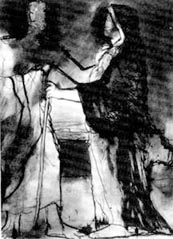|
|
Oedipus |
|
 If you've found this site useful, we'd really appreciate a small donation to help with the hosting costs. Thanks! |
According to numerous Picasso biographies, when Picasso was about thirteen years old, his father, a passionate amateur painter, gave him his paintbrushes and ceased painting altogether. This appears to have taken on great psychological significance later in Picasso's life for he equated it with patricide, a killing of his father's creativity. The paintbrush was to become an important symbol that Picasso identified with his own creative powers and masculinity. Picasso recognised the symbolic connection between this event in his early life and the Oedipus complex of Sigmund Freud. He then adopted Oedipus as a secretive alter ego because the story provided a wealth of symbolic associations that Picasso already identified with in his art.
In Sophocles' play, Oedipus is exposed as a baby boy by his father, the king of Thebes. The king did this to prevent the unfolding of a prophecy that he would die at the hands of his son. Oedipus' feet were pieced by a piece of wood and he was hung in a tree and left to die, but was rescued and bought up by shepherds. Picasso already identified with Crucifixion and so the Crucifixion aspect of the story reinforced his identification with Oedipus. Picasso's identification with Oedipus was strengthened still further because as soon as Oedipus realises that he has unwittingly killed his father and married his mother, he blinds himself and goes into self imposed exile. Blindness was an important theme for Picasso, he once stated that painting was a 'blind man's profession'. Themes of blindness emerged early in his pictures and recurred many times. Associated with soothsaying and prophecy, blindness had personal connotations for Picasso, for he was believed by some of his close friends to have had the power of prophecy. Exile was another feature of Picasso's life that provided a symbolic link with Oedipus. From 1904 onwards, Picasso lived the life of an exile for his art. He was also a member of the Spanish colony of Paris, many of whose members were political exiles because of their membership of the Anarchist movement with which Picasso was also closely linked. Then after 1936, Picasso swore not to return to Spain whilst Franco was in power. Oedipus, despite losing his prince's birthright eventually becomes a king. Picasso also identified with kings, we see this in his famous signature , 'Yo el Rey', and in a 1906 sculpted head where of harlequin as king. Christ, the king of the Jews, was another of Picasso's alter egos. Kingship was therefore an important feature in Picasso's choice of alter egos. There is a further link between Oedipus in Picasso's 1941 play, 'Desire Caught by the Tail,' in which an artist called 'Big Foot' takes one of the leading roles. 'Big Foot' has been closely identified with Picasso by art historians; his name appears to have been derived from the name of Oedipus which means 'Swollen Feet,' in its original Greek. © Mark Harris 1996
Further Reading: Picasso, Art as Autobiography, Mary Mathews Gedo, 1980 University of Chicago Press. Sophocles: Oedipus Rex Symbolism in the 1934 Drawing
Next Section: Alchemical Contexts |
|
|
|
     |
     |
|
|
© Mark Harris 1996 (content), Simon Banton 1996 (design) In general copyright of works by Pablo Picasso are the property of the heirs to the Pablo Picasso estate |
|

 Oedipus had been a popular theme amongst the Surrealists and others around Picasso in the 1920's. Picasso appears to have embraced the theme at around that time, this is apparent in a drawing he made on the subject in 1926.
Oedipus had been a popular theme amongst the Surrealists and others around Picasso in the 1920's. Picasso appears to have embraced the theme at around that time, this is apparent in a drawing he made on the subject in 1926.